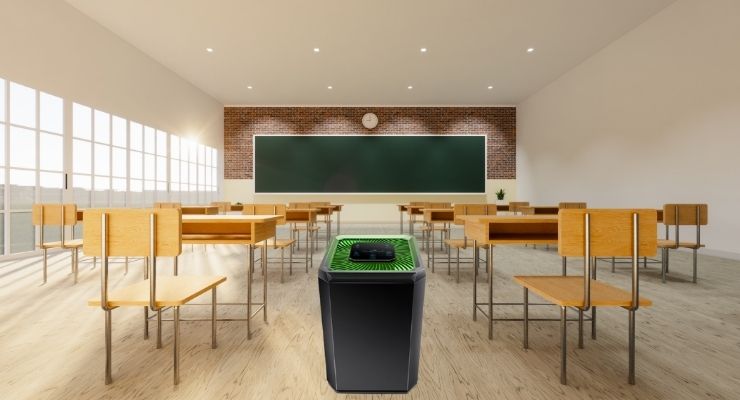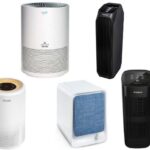Can air purifiers help in classrooms? The answer is YES! Air purifiers are great for classrooms because they can remove allergens and pollutants that may be harmful to students’ health.
Generally, air purifiers are proven to be the best source of relief from allergies and other conditions. In addition to air purifiers, there are a lot of other things you should consider when it comes to cleaning the air in your classroom. Read more about how air purifiers can improve your classroom environment below!
You won’t want to miss out on this guide, so grab a cup of coffee before you continue reading!
Why Would I Need An Air Purifier In My Classroom?
An air purifier can get rid of airborne bacteria and viruses to help students who are struggling with illness to breathe more easily. If sickness occurs on a school field trip, the student will have less severe symptoms if they are breathing clean air as opposed to polluted air.
Air purifiers can also improve concentration levels by removing particles that cause health problems like coughing and sneezing. Concentration levels go up when students have fewer distractions from things that make them feel bad.
Kids’ environments can be super dirty and full of allergens. If your kid is wheezing, coughing, has a runny nose, or has watery eyes; they could be suffering from respiratory problems. In some cases, the air in a classroom can be polluted with chemicals or toxic gases from nearby factories!
Even though you can’t see the pollutants in the air, these chemicals and gases are still there. Kids could be exposed unknowingly to contaminants like this if they are in classrooms that aren’t well-ventilated.
If you’re worried about your child’s respiratory health, the best way to prevent asthma triggers is to clean up the air in their classroom. The good news is that there are many air purifiers designed specifically for classrooms.
Can air purifiers help in classrooms?
Air pollution is the concern of every individual these days. The poor air quality in school classrooms can affect students and teachers alike. One way to get better breathing space at the workplace is by using an air purifier that filters impurities from indoor or outdoor environments, including schools. Air-purifying devices such as ionizers and HEPA (High-efficiency particulate air) filters are accessible and affordable, making them ideal for use in classrooms.
In schools, students and teachers spend a lot of time in indoor environments. Students tend to be more sensitive than most adults to exposure of air pollutants. Schools located in big cities with high levels of vehicular traffic and factories around have a higher level of exposure to air pollution due to particles that are emitted from these sources. This is one of the reasons why schools should use devices that will remove these particles from their vicinity.
The following are some ways in which air purifiers can help students and teachers in classrooms:
Reduced exposure to air pollutants
Air purifiers help in reducing the concentrations of airborne particles in indoor spaces. According to a research, pollution levels were found to be eight times higher indoors than outdoors.
Improved concentration and learning performance in students
Students suffer from headaches when exposed to poor quality air for prolonged periods. By getting an air purifier, schools can provide a better indoor environment for students to achieve improved concentration and learning performance.
Decreased absenteeism rate
Exposure to polluted air causes respiratory problems such as asthma as well as headaches that lead to poor academic performance. These factors cause fatigue and tiredness in students which leads to high school absenteeism rates. By using air purifiers, schools can reduce these health issues thereby reducing high absenteeism rates.
Improved overall health
Air pollution may cause eye and nose irritation as well as chronic diseases such as asthma and bronchitis. This makes it necessary for schools to use air purifiers to improve the health conditions of students and teachers alike, thereby increasing their longevity and productivity at school.
How Can You Improve Indoor Air Quality In Classrooms?
You can improve indoor air quality in classrooms by using an air purifier with a pre-filter and a HEPA filter combined. This process reduces the amount of viruses, bacteria, allergens, and pollutants that can cause health problems in students.
One air purifier brand that offers this technology is Blueair. They are one of the most trusted brands in the industry. When using an air purifier in your classroom, you should notice a big improvement in the overall health of staff members and students. This includes a reduction in headaches, coughing, and other health problems associated with pollutants.
This is a great solution for a classroom because the air purifier can be used on a daily basis, and it’s low maintenance.
Does Your Kid’s Classroom Need An Air Purifier?
Parents always want to do what is in the best interests of their kids. We desire for our children to be healthy and happy because it makes us feel better.
When they are in the classroom, your kids are exposed to numerous contaminants that can affect their health. You don’t have to kid yourself about this. Even if you are aware of these risks, it is hard to know what is happening inside the school building.
This is where air purifiers come in. They will help you monitor the environment so that you can do something about it if necessary. In addition, they are more affordable than you think and there’s no reason not to have one at home or at school.
So if you are trying to find a way for your kid’s classroom or school at large to have clean air, consider an air purifier. It might be a little bit more expensive than you can afford, but believe us when we say that it is worth it.
However, there are several alternatives to select from when it comes to this. You may locate the ideal air purifier for your child’s school right here on Amazon. They offer a variety of top brands of filters, including the best-selling Blue Pure 211+ Filter. That filter is great because it cleans up to 99% of pollutants in the air, which will help make the air safe and clean for your child.
So if you want to get an air purifier for your kid’s classroom or school at large, this is a great place to start.
What Can Air Purifiers Do to Keep Classrooms Safe?
Air purifiers keep classrooms safe. They remove smaller particles that can hurt you and make you sick. Concentrations of dust mites, pet dander, pollen from flowers and trees, and other allergens can be drastically reduced with an air purifier.
What Air Purifiers Should I Use In Classrooms?
There are many brands and styles of air purifiers available. It is recommended that you choose an air purifier with a HEPA filter and a pre-filter to remove dust, dirt, pollen, bacteria, and viruses from the air. The best thing to do is decide how much square footage needs to be covered and then choose an air purifier that covers that amount.
For example, if you want to purify the air in a 10’x10′ room, you would want an air purifier that covers 100 square feet.
What Are The Benefits Of An Air Purifier For Classrooms?
An air purifier can really improve your child’s classroom environment.
It doesn’t just remove all the allergens that cause allergies and respiratory problems, but it also reduces gases like formaldehyde, ammonia, carbon monoxide, and other chemicals in the air.
By using an air purifier, you can help your child breathe easier and stay healthy while at school!
These machines come in all shapes and sizes, which makes it easy to find ones that will fit into any classroom. You can also find air purifiers that are silent, small, or have energy-saving features.
The disadvantages of using an air purifier in a classroom
An air purifier will only remove the particles in the air, but it won’t prevent new ones from coming in. If you want to reduce the levels of chemicals and gases in your child’s classroom, you will need to use carbon filters or other special equipment along with an air purifier.
Since most of these gases are heavier than air, they will sink to the floor. So you will need to have more carbon filters or special equipment near the floor.
Should schools put air purifiers in every classroom?
Air purifiers should be placed in every classroom because air quality can vary from room to room. Depending on how well-ventilated a room is, the air quality can be poor or good.
It is difficult to keep all classrooms airtight, so the air purifier should help take care of things. You should also make an effort to keep the air in your child’s classroom clean by having occasional indoor air quality testing.
Regularly check for signs of poor air quality, including dusty surfaces and dirty walls.
You should also check for signs of poor ventilation, such as odors or stagnant air.
Do not expose your child to allergens or irritants at home after they have been in the classroom.
If they begin showing signs of allergies or respiratory distress, an air purifier may be needed.
Where to place air purifier in classroom?
You want to place your air purifier in a central location. The air purifier should be placed on the wall where it’s easy to access the air filter for regular cleaning, but it shouldn’t be in a place where you can trip on it.
Air purifiers work best when they are placed near the center of the room, preferably not next to a wall. This is because the air tends to get dirty when it is near the wall.
You’ll need to have some sort of ventilation in your classroom so that the air purifier can work properly. This means having windows near the air purifier to let new air into the room or having an open door to let out stale, polluted air.
Which Air Purifier Should Schools Choose for COVID-19 Protection in the Classroom?
The Bissell air400 is a very good choice for COIDV-19 protection in the classroom.
It is affordable and small enough to fit on top of a desk. It has four levels of operation, so it can be set to run quietly or quickly purify the air depending on your need.
The HEPA filter will lock in 99% of the particles that are 0.3 microns or larger, including pollen, mold spores, and pet dander.
It also has a washable pre-filter to trap large dust, hair, and other particles to extend the life of the HEPA filter.
Another plus is that it has an easy-to-use interface with controls on the front of the machine, so you can monitor air quality and turn the machine on or off with an easy press of a button.
It’s also very simple to clean, which is important when you have a lot of people in one room.
The large air filter is easy to clean with the push of a button, so you don’t have to worry about accidentally smudging it or damaging it.
It also has a low noise level, so you won’t have to worry about noise complaints from parents or students.
Parents will also appreciate that it can be programmed to turn on and off at specific times of the day, helping take care of your child’s asthma at home.
The sleek design is perfect for your desk. Not only does it have a small size, but the two-year warranty makes this model stand out from competitors with shorter periods of coverage!
Are Ionizer and Ozone Air Purifiers Safe for Students?
Ionizers are not recommended because they could cause ozone, which can worsen asthma. You don’t want any air purifier to emit ozone, which is harmful to breathe in.
So it’s best not to use an ozone air purifier in a classroom. Some air purifiers emit carbon dioxide, but this is not harmful to breathe in.
So with an air purifier emitting carbon dioxide, students will be able to enjoy clean air.
Things to consider before buying an air purifier for your classroom.
Size:
Air purifiers come in a range of sizes. If you have limited desk space, you may want to find an air purifier that’s compact and has a small footprint.
Filter Life:
The filter life of an air purifier is important, especially if you’re spending money on an air purifier.
Check to see how long the filter will last before it needs replacement. Some filters need to be replaced after a year, while others last for two years.
Clean Air Delivery Rate:
The CADR of an air purifier is a way to measure the amount of clean air an air purifier produces.
The higher the number, the better since this means it’s producing more clean air. The CER should be no less than 450, but the number can go up to 999.
Operation:
Check the amount of noise an air purifier emits before purchasing it.
It’s best that classrooms that are full of students and their gear are kept as silent as possible since loud models may not be good for students who have to finish exams or study.
Other models are super quiet and produce very little noise, so students can work without interruption.
The alen breathesmart 75i emits very little noise, so students won’t have to worry about a disturbance.
Budget:
Decide how much you want to spend on an air purifier for your classroom.
Air purifiers can cost as little as $150, which is more affordable than other models on the market. You’ll also find many affordable models on the market.
So it’s possible to find a model within your budget and still get an air purifier for your classroom.
What is the best air purifier for the classroom?
The ideal air purifier for a classroom is any that has a long filter life and filters out at least 99.5% of airborne particles. A Bissell air400 air purifier is perhaps your best option as it filters out 99.5% of airborne particles, and their filters last for 180 days.
However, if you are looking for something with added benefits such as fragrance discs or humidification disks, then I would recommend any of the PureGuardian gg1000 air purifiers.
Conclusion:
Can air purifiers help in classrooms? The answer seems to be yes, but not all air purifiers are created equal. Air purifier effectiveness varies depending on the type of filter it has and how often you change the filters. Make sure that your school or daycare is using an effective air purifier for this purpose if they want to keep kids healthy.
However, the benefits of air purification are numerous, but they may not be enough to make the cost seem worth it for many schools. If you’re looking to incorporate an air purifier in your classroom, take a look at these three things before making the decision.
First, consider how much time your students spend inside versus outside and if that changes throughout the year.
Second, think about what other environmental factors might be affecting their health, like mold or lead paint–air quality is just one small part of this equation.
Finally, research whether there’s any proof that clean indoor air actually improves academic performance by reducing absenteeism or improving concentration levels during class time. Once you’ve considered all those points and researched them thoroughly with us as well as





